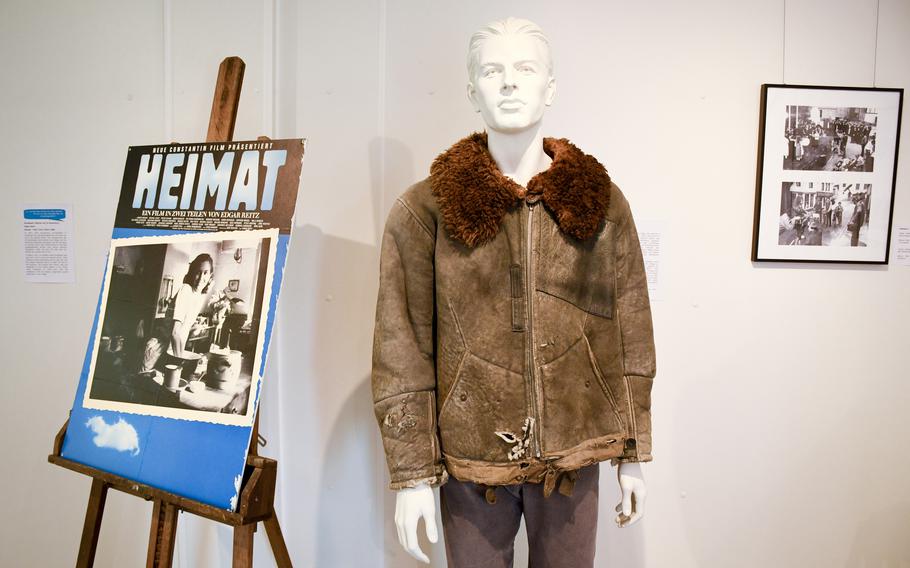
Early German movies and books about the Americans deployed to Ramstein Air Base focused on the swift changes that the soldiers had on the region as well as on fears of corruption, both financial and moral. (J.P. Lawrence/Stars and Stripes)
A strange sight greeted me as I entered the special exhibition at the Docu Center in Ramstein village: Call of Duty: Modern Warfare 3.
The 2011 video game sat in its green plastic shell atop a pedestal, protected by a display case and bathed in soft lighting, as if it were the Hope Diamond.
The exhibition takes visitors on a journey through the ways in which the nearby Ramstein Air Base and other bases have been depicted in highbrow art and pop culture over the decades.
“An American visitor would maybe be surprised how much German media or German music deals with Ramstein Air Base,” said Mario Aulenbacher, the center’s director. “It’s a big difference between the Germans’ idea of Ramstein Air Base, and the Americans’ idea.”
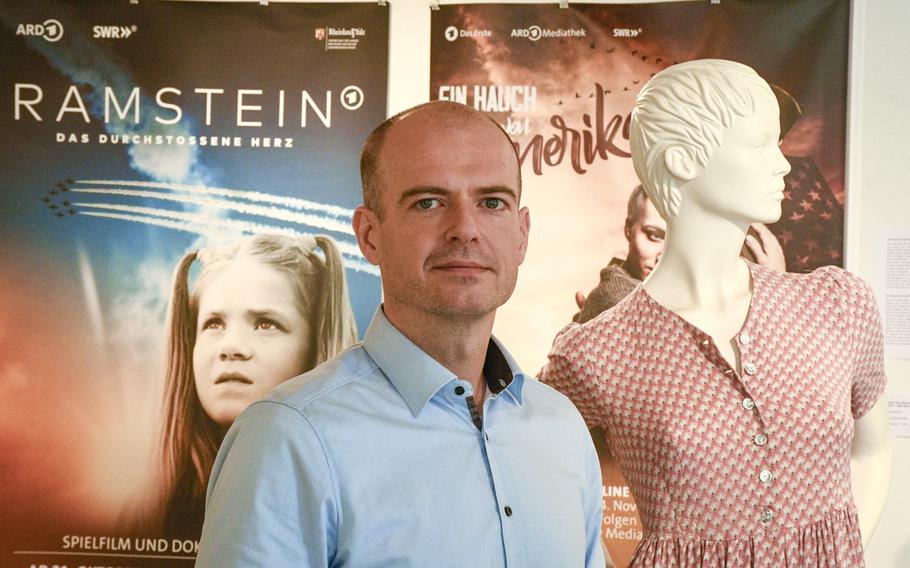
Mario Aulenbacher, director of Docu Center Ramstein, researched movies, books and video games for a project that examined how American and German artists depicted Ramstein Air Base over the years. (J.P. Lawrence/Stars and Stripes)
The movies, books and other works of art highlighted at the center offer an illuminating look at how Americans and Germans have differed in their views of the U.S. military presence in Rheinland-Pfalz, which the Docu Center says has been home of more than 170 U.S. military sites at different times over the decades.
In American pop culture, it seems that Ramstein is just another military airfield in a vast collection of strongholds around the world.
Posters for Hollywood movies are displayed near the video games at the exhibition, along with a blurb explaining how Ramstein is portrayed.
Whether in “Air Force One,” “Mission Impossible: Fallout” or “Knight and Day,” the base is often relegated to a transit hub, a temporary stop for protagonists on their way to or from more interesting locations.
Examples are given of U.S. network television shows that mention Ramstein, but these references are often a single line of hasty dialogue.
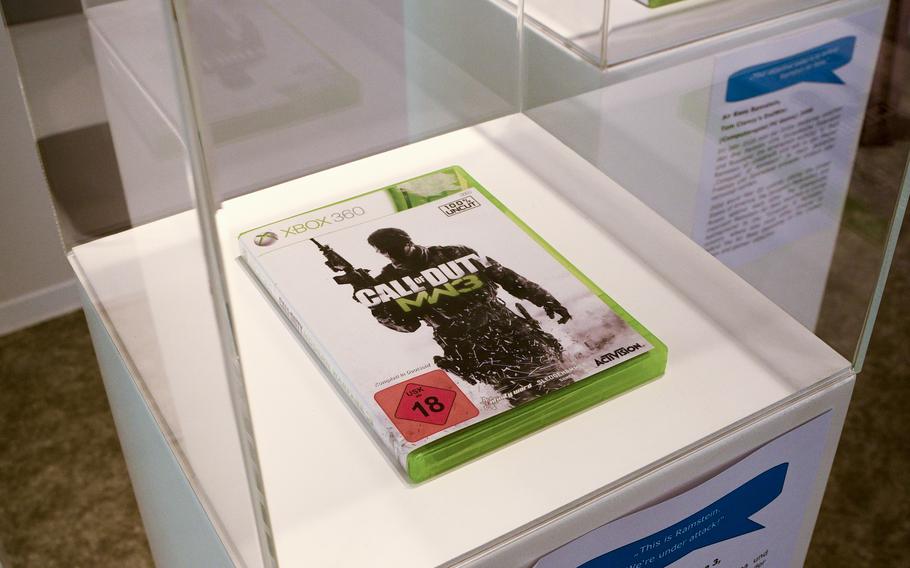
An exhibition running at Docu Center Ramstein in Germany showcases American media that refers to Ramstein Air Base, such as the video game Call of Duty: Modern Warfare 3, which has one level that mentions the base. American culture tends to use the base as a stepping stone to or from wars or conflict elsewhere. (J.P. Lawrence/Stars and Stripes)
Even Call of Duty mentions Ramstein almost as an afterthought, when during a Russian land invasion of Germany, the base is just another battlefield far away from the player’s location.
But for Germans, the base and the surrounding area hold a deeper meaning. The curated selection of German films, books and art provides a window into the anxieties and sentiments about the American military presence.
Early films, set against the backdrop of Ramstein’s establishment in the 1950s, show the fears that Germans had about the Americans moving into the region.
In film portrayals, Germans feared that the Americans brought with them moral decay, a penchant for drunken bar fights and a hunger for tawdry red-light districts.
To give some credit to the sensibilities of those mid-century Germans, on my way to the exhibition I did pass a crass ad for a strip club that said “pimp my booty.”
A section for movies and TV programs about the 1988 Ramstein air show disaster, which killed 70 people and injured hundreds, highlights how that horrific tragedy continues to resonate in the German psyche. A corner of the exhibit showcases the band Rammstein, which got its name from the airshow disaster.
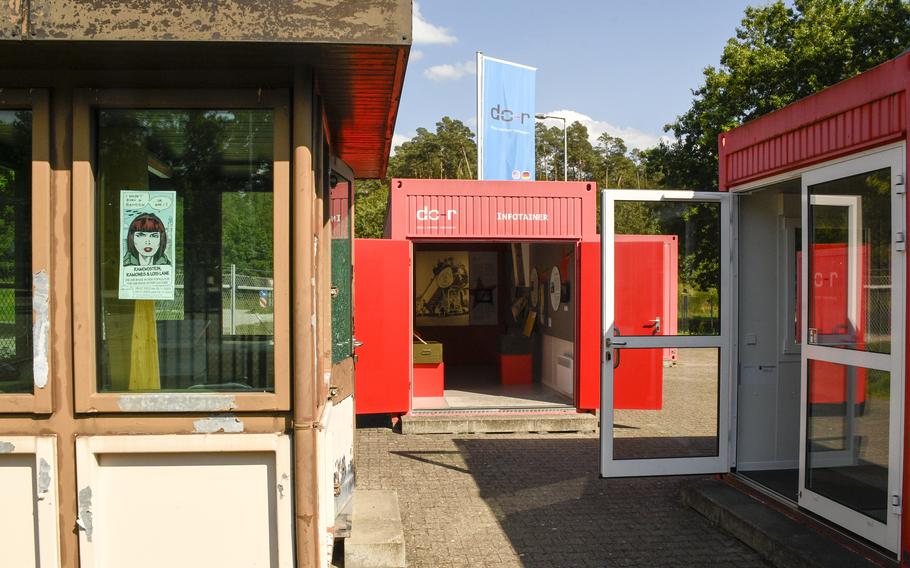
The special exhibit at the Docu Center Ramstein highlighting movies, video games and books depicting Ramstein Air Base runs until Nov. 5, 2023. (J.P. Lawrence/Stars and Stripes)
Later films highlighted another tension, as the Gulf War and especially the 9/11 attacks led to heightened security, the closure of the base’s gates and imposing fences that shut out civilians.
In the wake of that, Germans began believing more conspiracy theories about the Americans, said Aulenbacher, who recalled that as a child in the late 1980s, he could simply ride his bike onto the base in Baumholder.
Though the films do not explicitly castigate the American military or NATO, there exists a subtle undercurrent of critique, a common theme of wondering what evils those American troops must be hiding behind their fences and their insistent smiles.
In one show, German detectives search for a killer. The culprit is not the Middle Eastern immigrant they suspected, but instead an American drone pilot with post-traumatic stress disorder.
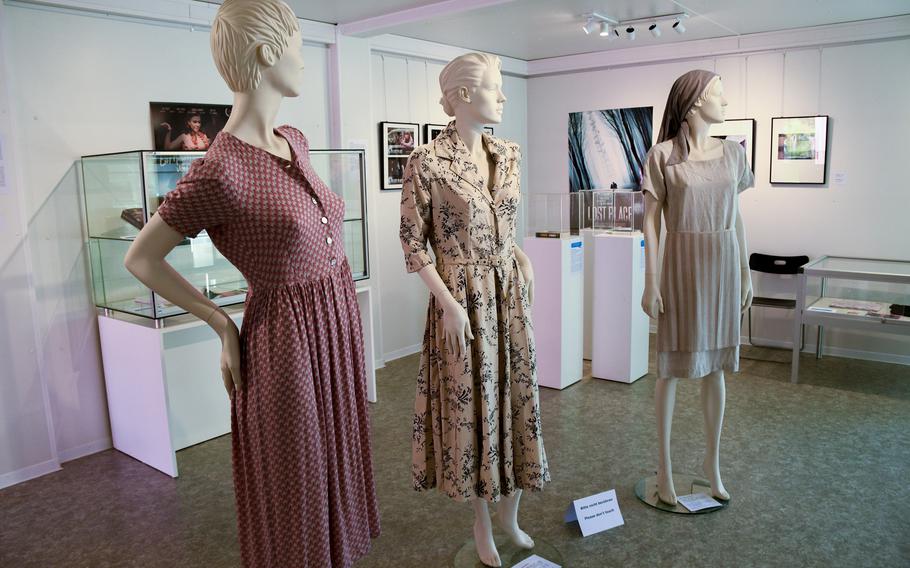
The Docu Center Ramstein features dresses worn in “Ein Hauch von Amerika” (A Touch of America), a six-episode drama that portrayed burgeoning relationships between Germans and American soldiers in the 1950s. (J.P. Lawrence/Stars and Stripes)
A display reminds visitors of the unsettling fact that notorious serial killers Jeffrey Dahmer and Gary Michael Heidnik once served as soldiers in this region during the Cold War.
My favorite discovery from the exhibit is the horror movie “Lost Place,” directed by a Kaiserslautern native.
The exhibition inspired me to watch the film, in which four teens venture into the region’s forests, where they stumble upon the villain: the U.S. military-industrial complex.
Their happy walk ends when they discover a hidden American base where secret experiments take place, kicking off a plot that ends in a radioactive nightmare.
The movie gave me pause for reflection on the sobering notion that in a real nuclear war, this area would be a primary target.
It encapsulated the duality of life next to Ramstein, where people complain that nothing ever happens, and then a fighter jet zooms overhead.
The assemblage of American and German art at the Docu Center may at times turn into a mere game of recognition for those who have watched these films or a “see also” Wikipedia page but in real life.
And yet the exhibition also serves as a great entry point into the cultural tapestry depicting the region’s complex relationship with Ramstein.
Docu Center Ramstein
Address: Schernauer Strasse 46, Ramstein-Miesenbach. Near the Azur swimming pool, across the street from the Reichswald-Gymnasium.
Hours: Tuesday through Sunday, 2-5 p.m.; the special exhibition runs through Nov. 5.
Cost: Free
Information: Online: dc-ramstein.de; info@dc-ramsteinde; +49 6371-838-005. Most displays are in English and German. Guided tours are available upon request.